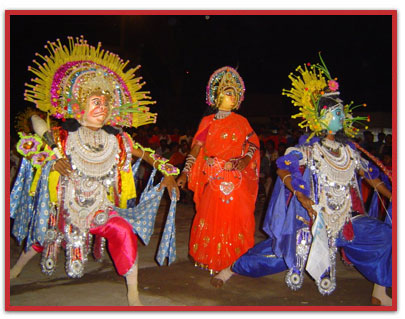Chhau Classical Dance
 The etymological root of the word 'Chhau' is traced to the Sanskrit 'Chhaya' or shade, referring to the mask used by the dancers. Chhau dance is evidently a war dance. The steps and movements, the attack and defence, the performers, each holding a sword and shield.
The etymological root of the word 'Chhau' is traced to the Sanskrit 'Chhaya' or shade, referring to the mask used by the dancers. Chhau dance is evidently a war dance. The steps and movements, the attack and defence, the performers, each holding a sword and shield.Themes are based on mythology, everyday life, aspects of nature or just a mood or emotion. Rituals connected with Chhau spread throughout the year beginning from Dussehra. Actual training of the Chhau starts from the day of 'Sri Panchami'. A number of rituals are performed primarily to call upon the divine blessing.
Music is based on Hindustani Ragas. The accompaniment is with a Nagra, a huge kettledrum, Dhol, a cylindrical drum, and Shenais or reed pipes.
It is a type of dance, which takes utmost care in expressing emotion and feeling - anger, fear, laughter, wonder or sorrow. Chhau dance follows certain fundamental traditions of the classical modes as detailed in the ancient treatises.The solo dancers were simply displaying stylised vigorous movements with sword and shield in hands.
Folk Dances of India 

